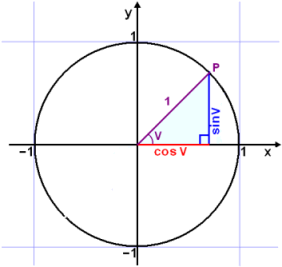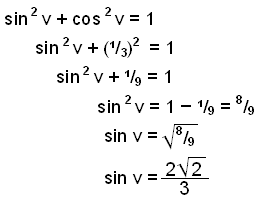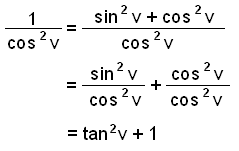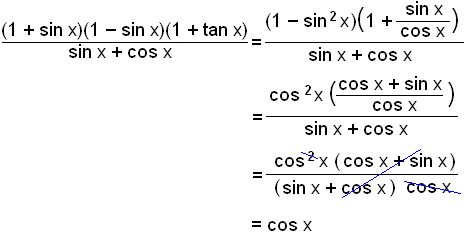| © 2008 Rasmus ehf and Jóhann Ísak | Trigonometry Rules |
|
Mathematics has many rules that help us to simplify and there by solve the more complicated trig equations.
We are now going to find and use one of them, probably the most useful one of all.
This rule is often called Pythagoras rule for sines and cosines. The diagram shows a right angled triangle drawn in the unit circle. Pythagoras rule is true for all points P is on the unit circle. This means that This rule is usually written in the form: |
 |
|
sin 2 v + cos 2 v = 1 |
It can be rewritten in two ways:
|
sin 2 v = 1 − cos 2 v |
and
|
cos 2 v = 1 - sin 2 v |
Example 1
|
Find sin x if cos x =
⅓ and 0 |
|
(x is an angle between 0° and 90°).
We can solve this problem
using a calculator,
cos −1 (⅓)
≈ 70.53° and therefore sin
70.53° ≈ 0.94. If we want an exact answer
we can do this example without a calculator, using Pythagoras rule.

Use the rule sin 2 v + cos 2 v = 1 to find other ways of writing the expression 1/ cos 2 v.
One way is by moving sin 2 v over the equals sign, so that we get cos 2 v = 1 − sin 2 v and then inverting both sides of the equation. This gives us

There’s another, not so obvious way, that leads to an expression that can often be useful. Look what happens if we divide the original equation, sin 2 v + cos 2 v = 1, by cos 2 v.

We have now proved the rule:

We will now use Pythagoras for trig functions to find the value of, first sin 2 v then cos 2 v, given sin 2 v = cos 2 v.
We first replace cos 2 v using the rule cos 2 v = 1 − sin 2 v.
sin2 v = cos2 v
sin2 v = 1 − sin2 v
2×sin2 v = 1
sin2 v = ½
Now we replace sin 2 v using sin 2 v = 1 − cos 2 v.
sin2 v = cos2 v
1 − cos2 v = cos2 v
1 = 2×cos2 v
cos2 v = ½
Example 4Solve the equation cos 2 x = sin x + 1.
First replace cos 2 x.
cos2 x = sin x + 1
1 − sin2 x = sin x + 1
0 = sin2 x + sin x = sin x (sin x + 1)
This leads to sin x = 0 or sin x = −1, so that
x = k×p (k×180°) or x = 3p/2 + k×2p (270° + k×360°).
Example 5Simplify the equation 
 |
Here we use the rule that (a + b)(a − b) = a2 − b2 and then rewrite tan x as í sin x/cos x before simplifying |
Try Quiz 1 on Trigonometry Rules.
Remember to use the checklist to keep track of your work.